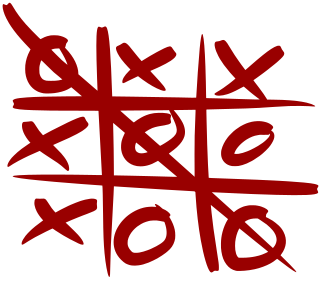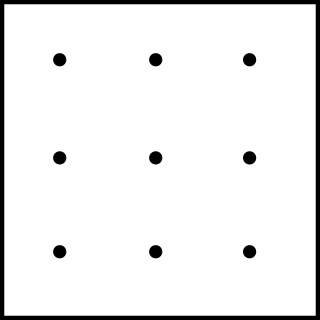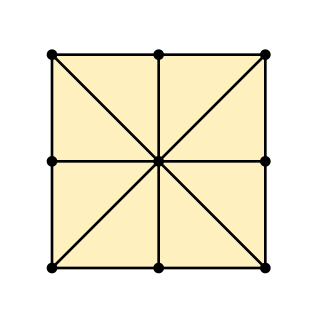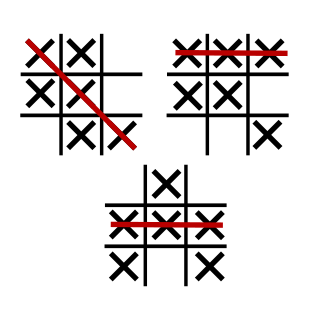
Tic-tac-toe, noughts and crosses, or Xs and Os is a paper-and-pencil game for two players who take turns marking the spaces in a three-by-three grid with X or O. The player who succeeds in placing three of their marks in a horizontal, vertical, or diagonal row is the winner. It is a solved game, with a forced draw assuming best play from both players.

Nine men's morris is a strategy board game for two players dating at least to the Roman Empire. The game is also known as nine-man morris, mill, mills, the mill game, merels, merrills, merelles, marelles, morelles, and ninepenny marl in English. The game has also been called cowboy checkers and is sometimes printed on the back of checkerboards. Nine men's morris is a solved game, that is, a game whose optimal strategy has been calculated. It has been shown that with perfect play from both players, the game results in a draw.

Fanorona is a strategy board game for two players. The game is indigenous to Madagascar.
Three men's morris is an abstract strategy game played on a three by three board that is similar to tic-tac-toe. It is also related to six men's morris and nine men's morris. A player wins by forming a mill, that is, three of their own pieces in a row.

3D tic-tac-toe, also known by the trade name Qubic, is an abstract strategy board game, generally for two players. It is similar in concept to traditional tic-tac-toe but is played in a cubical array of cells, usually 4x4x4. Players take turns placing their markers in blank cells in the array. The first player to achieve four of their own markers in a row wins. The winning row can be horizontal, vertical, or diagonal on a single board as in regular tic-tac-toe, or vertically in a column, or a diagonal line through four boards.

Toss Across is a game first introduced in 1969 by the now defunct Ideal Toy Company. The game was designed by Marvin Glass and Associates and created by Hank Kramer, Larry Reiner and Walter Moe, and is now distributed by Mattel. It is a game in which participants play tic-tac-toe by lobbing small beanbags at targets in an attempt to change the targets to their desired letter. As in traditional tic-tac-toe, the first player to get three of their letters in a row wins the game. There are other similar games to Toss Across known under different names, such as Tic Tac Throw.

Nine Holes is a two-player abstract strategy game from different parts of the world and is centuries old. It was very popular in England. It is related to tic-tac-toe, but even more related to three men's morris, Achi, Tant Fant, Shisima, Picaria, and Dara, because pieces are moved on the board to create the 3 in-a-row. It is an alignment game.

Achi is a two-player abstract strategy game from Ghana. It is also called tapatan. It is related to tic-tac-toe, but even more related to three men's morris, Nine Holes, Tant Fant, Shisima, and Dara, because pieces are moved on the board to create the 3-in-a-row. Achi is an alignment game.

Tant Fant is a two-player abstract strategy game from India. It is related to tic-tac-toe, but more closely related to three men's morris, Nine Holes, Achi, Shisima, and Dara, because pieces are moved on the board to create the 3 in-a-row. It is an alignment game.
Shisima is a two-player abstract strategy game from Kenya. It is related to tic-tac-toe, and even more so to three men's morris, Nine Holes, Achi, Tant Fant, and Dara, because pieces are moved on the board to create the 3-in-a-row. Unlike those other games, Shisima uses an octagonal board.

Picaria is a two-player abstract strategy game from the Zuni Native American Indians or the Pueblo Indians of the American Southwest. It is related to tic-tac-toe, but more related to three men's morris, Nine Holes, Achi, Tant Fant, and Shisima, because pieces can be moved to create the three-in-a-row. Picaria is an alignment game.
Pasang is a two-player abstract strategy board game from Brunei. The game is often referred to as Pasang Emas which is actually a software implementation of the traditional board game. The object of this game is to acquire the most points by capturing black and white tokens on the board. Black tokens are worth 1 point, and white tokens are worth 2 points. The board is initially laid out with all 120 black and white tokens in one of over 30 traditional patterns. Players choose a piece called a "ka" which is used to capture the tokens on the board. Each player's "ka" moves around the board capturing as many tokens as possible. As a note, the "kas" are the only mobile pieces in the game. The other pieces are stationary, and are captured by the "kas". Players must capture token(s) during their turn, or lose the game. When all tokens have been captured from the board, the player with the most points is the winner. However, if there are any tokens left on the board, and none can be captured on a player's turn, then that player loses the game, and the other player is the winner.
Tsoro Yematatu is a two-player abstract strategy game from Zimbabwe. Players first drop their three pieces onto the board, and then move them to create a 3 in-a-row which wins the game. It is similar to games like Tapatan, Achi, Nine Holes, Shisima, and Tant Fant. However, what makes this game unique is that pieces can jump over each other which adds an extra dimension in the maneuverability of the pieces.
Wali is a two-player abstract strategy game from Africa. It is unknown specifically which African country the game originates from. Players attempt to form a 3 in-a-row of their pieces, and in doing so capture a piece from their opponent. The game has two phases: Drop Phase and Move Phase. Players first drop as many of their pieces as possible in the Drop Phase, then move them to form 3 in-a-rows which allows them to capture the other player's pieces in the Move Phase.

Zillions of Games is a commercial general game playing system developed by Jeff Mallett and Mark Lefler in 1998. The game rules are specified with S-expressions, Zillions rule language. It was designed to handle mostly abstract strategy board games or puzzles. After parsing the rules of the game, the system's artificial intelligence can automatically play one or more players. It treats puzzles as solitaire games and its AI can be used to solve them.
Dala is a two-player abstract strategy board game from Sudan, and played especially by the Baggara tribes. The game is also called Herding the Cows. It is an alignment game with captures similar to that of the game Dara. Players first drop their pieces onto the board, and then move them orthogonally in an attempt to form 3 in-a-rows which allows a player to capture any of their opponent's piece on the board.

Ultimate tic-tac-toe is a board game composed of nine tic-tac-toe boards arranged in a 3 × 3 grid. Players take turns playing in the smaller tic-tac-toe boards until one of them wins in the larger tic-tac-toe board. Compared to traditional tic-tac-toe, strategy in this game is conceptually more difficult and has proven more challenging for computers.

Notakto is a tic-tac-toe variant, also known as neutral or impartial tic-tac-toe. The game is a combination of the games tic-tac-toe and Nim, played across one or several boards with both of the players playing the same piece. The game ends when all the boards contain a three-in-a-row of Xs, at which point the player to have made the last move loses the game. However, in this game, unlike tic-tac-toe, there will always be a player who wins any game of Notakto.

Tic-tac-toe is an instance of an m,n,k-game, where two players alternate taking turns on an m×n board until one of them gets k in a row. Harary's generalized tic-tac-toe is an even broader generalization. The game can also be generalized as a nd game. The game can be generalised even further from the above variants by playing on an arbitrary hypergraph where rows are hyperedges and cells are vertices.
Treblecross is a degenerate tic-tac toe variant. The game is an octal game, played on a one-dimensional board and both players play using the same piece. Each player on their turn plays a piece in an unoccupied space. The game is won if a player on their turn makes a line of three pieces in a row.












